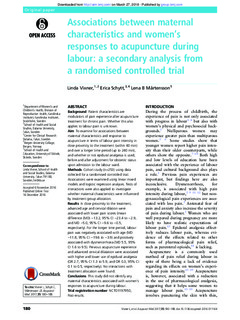| dc.contributor.author | Vixner, Linda | |
| dc.contributor.author | Schytt, Erica | |
| dc.contributor.author | Mårtensson, Lena B | |
| dc.date.accessioned | 2019-03-15T09:32:16Z | |
| dc.date.available | 2019-03-15T09:32:16Z | |
| dc.date.created | 2018-01-22T15:11:16Z | |
| dc.date.issued | 2017 | |
| dc.identifier.citation | Vixner, L., Schytt, E., & Mårtensson, L. B. (2017). Associations between maternal characteristics and women's responses to acupuncture during labour: A secondary analysis from a randomised controlled trial. Acupuncture in Medicine, 35(3), 180-188 | nb_NO |
| dc.identifier.issn | 0964-5284 | |
| dc.identifier.uri | http://hdl.handle.net/11250/2590168 | |
| dc.description.abstract | Background
Patient characteristics are modulators of pain experience after acupuncture treatment for chronic pain. Whether this also applies to labour pain is unknown.
Aim
To examine for associations between maternal characteristics and response to acupuncture in terms of labour pain intensity in close proximity to the treatment (within 60 min) and over a longer time period (up to 240 min), and whether or not epidural analgesia is used, before and after adjustment for obstetric status upon admission to the labour ward.
Methods
Cohort study (n=253) using data collected for a randomised controlled trial. Associations were examined using linear mixed models and logistic regression analyses. Tests of interactions were also applied to investigate whether maternal characteristics were influenced by treatment group allocation.
Results
In close proximity to the treatment, advanced age and cervical dilation were associated with lower pain scores (mean difference (MD) −13.2, 95% CI −23.4 to −2.9; and MD −5.0, 95% CI −9.6 to −0.5, respectively). For the longer time period, labour pain was negatively associated with age (MD −11.8, 95% CI −19.6 to −3.9) and positively associated with dysmenorrhoea (MD 5.5, 95% CI 1.6 to 9.5). Previous acupuncture experience and advanced cervical dilatation were associated with higher and lower use of epidural analgesia (OR 2.7, 95% CI 1.3 to 5.9; and OR 0.3, 95% CI 0.1 to 0.5, respectively). No interactions with treatment allocation were found.
Conclusions
This study did not identify any maternal characteristics associated with women's responses to acupuncture during labour. | nb_NO |
| dc.language.iso | eng | nb_NO |
| dc.publisher | British Medical Acupuncture Society | nb_NO |
| dc.rights | Navngivelse-Ikkekommersiell 4.0 Internasjonal | * |
| dc.rights.uri | http://creativecommons.org/licenses/by-nc/4.0/deed.no | * |
| dc.subject | acupuncture | nb_NO |
| dc.subject | obstetrics | nb_NO |
| dc.subject | pain management | nb_NO |
| dc.title | Associations between maternal characteristics and women's responses to acupuncture during labour: A secondary analysis from a randomised controlled trial | nb_NO |
| dc.type | Journal article | nb_NO |
| dc.type | Peer reviewed | nb_NO |
| dc.description.version | publishedVersion | nb_NO |
| dc.rights.holder | © The Author(s) | nb_NO |
| dc.subject.nsi | VDP::Medisinske Fag: 700::Helsefag: 800::Andre helsefag: 829 | nb_NO |
| dc.source.pagenumber | 180-188 | nb_NO |
| dc.source.volume | 35 | nb_NO |
| dc.source.journal | Acupuncture in Medicine | nb_NO |
| dc.source.issue | 3 | nb_NO |
| dc.identifier.doi | 10.1136/acupmed-2016-011164 | |
| dc.identifier.cristin | 1549359 | |
| cristin.unitcode | 203,3,0,0 | |
| cristin.unitname | Avdeling for helse- og sosialfag - Bergen | |
| cristin.ispublished | true | |
| cristin.fulltext | original | |
| cristin.qualitycode | 1 | |

